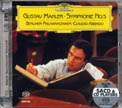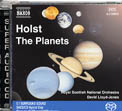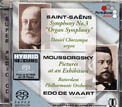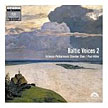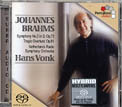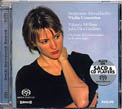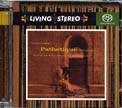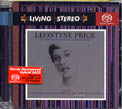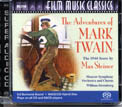|
You are reading the older HTML site
Positive Feedback ISSUE
16
Hi-Res reviews featuring our friends from Audiophile Audition Selections from the 42 SACD & DVD-A Reviews for this month - November 2004 This time we review two more of the new RCA Living Stereo 3-channel SACDs and two more of the Nimbus 4-channel DVD-As plus two SACDs from Naxos. MULTICHANNEL DISC OF THE MONTH
MAHLER:
Symphony No. 5 - Berlin Philharmonic/Claudio Abbado (rec. live) - DGG
multichannel SACD 477 071-2 (2 discs) - 44:48, 24:44
5
Stars
Record live in the Berlin Philharmonie Hall in 1993, this is a
magnificent performance full of electricity, played to a fare thee well
by the organization many consider the world's top symphony orchestra.
Though it may be said to have no specific program, the Fifth opens with
a Funeral March and the rest of its 69-minute length is devoted to
reflecting on, transcending and justifying what that march implies. (And
why didn't DGG put the entire symphony on a single disc then, since they
hold up to 80 minutes? If this is a two-discs-for-price-of-one album,
then it doesn't really matter.) The march is one of two "orchestral
songs" heard in the work; the other is the famous Adagietto movement—often performed separately. This is just about the most heart-rending
version of that movement I have ever heard. The work's Rondo-Finale is a
summation of all the contrasts found cheek-by-jowel in most Mahler
symphonies—from desparation to the greatest exhaltation in seconds.
The climaxes are searing in their power and impact. The surround audio
is listed on the jewelbox as being only 44.1K/24 bit but it doesn't seem
to hamper the transparency of the frontal channels. However, the
surrounds don't carry much information about the hall acoustics. This is
where the San Francisco Symphony Mahler series outshines competing
surround recordings. That series hasn't gotten around to the Fifth yet
but when they do they will have a challenge to surpass this highly
recommended disc duo. John Sunier
HOLST:
The Planets; The Mystic Trumpeter - Claire Rutter, Soprano, with the
Ladies of the RSNO Chorus - Royal Scottish National Orchestra/David
Lloyd-Jones, Conductor - Naxos 6.110004 - Multichannel Hybrid SACD - 69:00 3
Stars
This is the first of the Naxos SACDs I've had the opportunity to hear,
and I was quite impressed with what I heard here. There are countless
available versions of The Planets, and David Lloyd-Jones and the RSNO
acquit themselves admirably with a bracing delivery of this old
warhorse. The tempos might be a bit rapid in places for certain tastes
(the breakneck speed of "Mars," for example), but the overall
performance is excellent, and the enhanced resolution of the SACD medium
helps lift this disc far above it's original Redbook issue.
This disc is a 5.1 release (most of their others have been 5.0), and the
use of the subwoofer channel helps significantly in areas where the CD
layer seems compressed and congested, such as massed brasses and
percussion, which abound throughout. As far as hi-res Planets go, I
think it's hard to top Gardiner on DG, but the inclusion of Holst's
rarely performed "Mystic Trumpeter" adds significant value to an already
striking disc. Recommended. Tom Gibbs
SAINT-SAENS: Symphony No. 3 "Organ" - MOUSSORGSKY - Pictures at an Exhibition
-
Daniel Chorzema, Organ (Saint-Saens) - Rotterdam Philharmonic Orchestra/Edo de Waart,
Conductor - Pentatone PTC 5186 116 - Multichannel Hybrid
SACD - 68:00, 2
Stars
Another of entatone's RQR releases (Remastered Quadro Recordings)—their excellent series of original Quad recordings from the
mid-seventies—this disc pairs two more venerable chestnuts of which
there are countless available choices to pick from. The recording
quality is really quite good, but just didn't seem to pack the requisite
orchestral heft that each of these pieces demand. I've been listening to
the recent RCA Living Stereo SACDs quite a bit lately, and the
near-definitive three-channel performances of these works by Munch
(Saint-Saens) and Reiner (Moussorgsky) make these versions seem rather
lacking by comparison. The value of the RQR series is that after
thirty-or-so years, you finally get to hear these recordings in
four-channel sound, as they were originally intended—and most of the
releases so far have been superb—but the competition for your dollar
is pretty stiff. At roughly the same price, I'd go for both RCAs, with
generous additional music, to boot. Tom Gibbs
Baltic
Voices 2 - Estonian Philharmonic Chamber Choir/Paul Hillier, Director - Harmonia Mundi HMU
807331 - Multichannel Hybrid SACD - 68:00,
5
Stars
This disc represents the third release on Harmonia Mundi by Paul Hillier
and the Estonian Philharmonic Chamber Choir, and the results again are
no less impressive. The choral compositions are, as on Baltic Voices 1,
from contemporary Baltic composers, and include two world premieres
among them. As with the previous two discs, the performances and
recorded sound are absolutely stunning. Careful inspection of the liner
notes this time around reveals that the disc was recorded, edited and
mastered in DSD, with engineering assistance from Polyhymnia (That
confirms my earlier suspicions about the superb sonic origins of these
discs). Not to be missed—very highly recommended!! Tom Gibbs
BRAHMS:
Symphony No. 2; Tragic Overture - Netherlands Radio Symphony Orchestra/Hans Vonk, Conductor
- Pentatone PTC 5186 042 - Multichannel Hybrid SACD - 59:00 4 Stars
This excellent offering from Pentatone and the recently departed Hans
Vonk (RIP) is the only readily available Brahms 2 on SACD. The superb
recording is all DSD, and provides an expansive soundstage and
impressive recreation of the recorded acoustic. The performances are
first-rate as well, and although Hans Vonk was not an extremely
well-known conductor here in the US, if these recordings are at all
representative of his mastery of the music, he'll be sorely missed.
Brahms' Second symphony has always been one of my guilty pleasures;
while many prefer the drama provided by the First or Fourth symphonies,
musically, there's so much to be gotten here. The serenity and
impassioned majesty of the opening movement segues into the hauntingly
mysterious second movement, followed by the lilting, almost waltz-like
quality of the minuet and scherzo of the third movement; all is resolved
by the unabashedly joyous finale.
Although the multichannel content of the recording is only listed as
5.0, I didn't find it to be at all lacking in bass, and orchestral
climaxes had tremendous impact, especially in the dramatic Tragic
Overture. Highly recommended. Tom Gibbs
BEETHOVEN
/ MENDELSSOHN: Violin Concertos - Victoria Mullova, Violin - Orchestre
Revolutionnaire et Romantique / John Eliot Gardiner, Conductor - Philips
470 629-2 - Multichannel Hybrid SACD - 68:00 4 Stars
I got this disc at the same time as I also got the RCA Living Stereo
SACD release with Jascha Heifetz that duplicated the program selection
exactly, so it's been interesting comparing and contrasting the two
discs. Whereas the RCA disc took more of a modern approach orchestrally,
and also featured Heifetz' violin prominently in the center channel (on
the Mendelssohn concerto), this disc from Philips featuring vioinist
Victoria Mullova takes a completely different track musically. The
center channel is completely absent here, which I'm not sure that I
entirely like—although some have criticized it's usage on the RCA disc
as sounding "unnatural," I found it to be quite effective, and would
have liked to have heard Ms. Mullova a little more prominently featured
in the middle. The Orchestre Revolutionnaire et Romantique gives the
music more of an "original instrument" delivery (versus the "big-band"
sound of the RCAs), which again, I have not always felt served the music
well, and has often seemed a bit thin and underwhelming, to say the
least. Nothing could be further from the truth here, as the orchestral
sound is very dynamic, with great impact on orchestral climaxes; strings
are sweet and lush throughout. Ms. Mullova's violin tone is superb, even
if a bit recessed in the mix—it sounds very much as it would in a live
concert.
There's very little here in the way of information on the origins of the
recording—which is unusual for Philips, who usually at least give
information as to whether the recording is from a DSD original or not.
Polyhymnia, who usually does such an incredible job for Philips, did not
handle the session, so I suspect that a 24/96 PCM original tape was
used; the sound is superb, regardless. I've never had any real
appreciation for John Eliot Gardiner's conducting style, but he
continues to impress me with every new release. Highly recommended. Tom Gibbs
TCHAIKOVSKY:
Symphony No. 6 "Pathetique" - Boston Symphony Orchestra/Pierre Monteux,
Conductor - RCA Living Stereo CRCA 61397 SA - Stereo SACD - 44:00
3
Stars
Of the two-dozen or so RCA Living Stereo titles I'd have chosen from for
the initial release on SACD, this 1955 date with Monteux and the BSO
would not have been among them. Not that it's a bad recording—although, personally, I find it pretty unexceptional in just about every
respect—it's just that there are other RCAs (and Monteuxs, for sure)
that should have merited inclusion. The nine other current RCA SACDs
have blown me away, especially the three-channel offerings, and have
left me frothing over what the next batch will contain (Pines of Rome? Sheherazade? The Reiner Sound?).
Again, it's not that this is such a bad disc—I just don't think its in
the same league sonically as the other Living Stereo titles, and there
are much more compelling Tchaik 6's out there (Mravinksky on DG, for
example). I don't plan on getting rid of this disc anytime soon, but I
don't foresee it in heavy rotation either. Tom Gibbs
Verdi
and Puccini Arias - Leontyne Price, Soprano - Rome Opera House Orchestra/Oliverio de Fabritiis, Conductor
- RCA Living Stereo CRCA 61395 SA -
Multichannel Hybrid SACD - 46:00 4 Stars
This collection of Verdi and Puccini Arias is often referred to as
the "Blue Album," and this new multichannel SACD from RCA Living Stereo
gives it to us finally in all its glory. The program that Leontyne Price
delivers is a near-perfect one, her vocal tone is flawless and the
orchestral support is superb. For the first time we get to hear this
album in its original three-channel incarnation; only the selections
from "Il Trovatore" are in stereo, and are a slight disappointment,
because they exhibit the same left-right quality so often heard in the
older LSCs. Having Leontyne Price's voice anchored in the center channel
is fabulous—if you're only listening to these discs in stereo, you
don't know what you're missing! The program length is a bit on the short
side, but what else would RCA have coupled this with? This is such an
enjoyable disc, the playing time just passes way too quickly. A perfect
introduction to opera for those who might be a little opera-squeamish.
Not to be missed, and very highly recommended! Tom Gibbs
MAX
STEINER: The Adventures of Mark Twain - score for the 1944 film, as
restored by John Morgan - Moscow Symphony Orchestra and Chorus/William
Stromberg - Naxos Film Music Classics multichannel SACD 6.110087 - 70:49
4 Stars
Another in the continuing Naxos series of new recordings of classic
film scores, which could be seen as encoring the earlier efforts of
Charles Gerhardt in making new recordings in state of the art sound with
a larger orchestra than usually used on the original optical sound film
tracks. Only now the state of the art is multichannel 5.0 SACD and since
it is outrageously expensive to record such in the U.S., the Moscow
players (as well as players in Prague) have become totally adept at
performing these film scores with great gusto and technical skill.
I remember as a child seeing this movie and being very moved by its
revealing that Samuel Clemens was born when Halley's Comet came, and
that it returned when he died. There's cues for that among these 29
tracks, as well as others with titles like Pirates, Frogs, The Squirrel,
Darn Coat Tails, Meeting General Grant, and Buggy Ride. Some of the use
of bassoon and banjo for humor reminded me of Ferde Grofe's Mark Twain
Suite. Whistling and some other special effects are part of the score.
Steiner had come to the U.S. in l914, way before the group of German
composers who were escaping WW II later on. He had studied with Mahler,
and quickly picked up the American musical idiom. His biggest soundtrack
success was Gone With the Wind. This film, which starred Frederic March
as Twain, was quickly forgotten. (But I remembered it.) Too bad Naxos
couldn't include a few minutes off the original film optical track at
the end of the disc so one could hear what a tremendously different
experience it is hearing the music in this richly orchestrated and
restored surround sound form. The surround sonics are superb; this disc
doesn't say anything on the jewel box about 41K or 48K sampling, so
perhaps Mosfilm Studio is using higher-res gear at this point. While
they didn't have surround in the theaters in l944 (except for Fantasia),
it just seems more like a movie experience to have surround sound coming
at you for a film score—especially in the big Finale where the chorus
that's been waiting around the samovar all this time finally does its
thing... John Sunier
Here are two more of the new Nimbus DVD-As with some unusual
features...
Actual title: Surround Yourself With BEETHOVEN: Leonore Overture No. 2;
Symphony No. 5 in C Minor; Symphony No. 6 in F Major "Pastoral"
- The
Hanover Band/Monica Huggett & Roy Goodman - Nimbus Records multichannel
DVD-A, also DTS & PCM stereo NI 9004, 89:30 4 Stars
Goodman and the Hanover Band made over 100 recordings for Nimbus. They
were among the first in presenting the orchestral music of Beethoven and
his contemporaries in a form that Beethoven himself would recognize.
Among the changes in such historical interpretation were often faster
tempi, a lower pitch for the entire orchestra, a more intimate chamber
music approach, and a different way of handling accents and dynamics.
Most of the recordings here were made in the late 1980s and recorded in
UHJ, the two-channel mixdown of Ambisonics surround. In these DVD-As
Nimbus has chosen to forego Dolby Digital and offer only 4.0 DTS and
standard two-channel PCM for those with only DVD video players. When
played on a DVD-A player, the discs default to 4-channel MLP. No video
display is required, but there is a short screen display of the titles
of the various selections and movements. I was unable to access the DTS
option with my one DVD video player, but using the PCM stereo option I
was able to use Dolby Pro Logic II on the signal—which carries the
original UHJ Ambisonic information. This produced a good center channel
(Nimbus doesn't use that) as well as strong surround signals. They were
not as clean and direct-sounding as the surround channels on the DVD-A
option, but with the center produced a surround field nearly as well as
the DVD-A layer. I haven't yet hooked up my Ambisonic UHJ decoder, but
will report on that in future. Meanwhile, ProLogic II does a bang up
job.
All the Beethoven performance are fresh-sounding and interesting to
hear. Even the overplayed Fifth Symphony sounds less lugubrious and more
musical than I recall hearing before. And you won't find 90 minutes of
music on a single optical disc in either the standard CD or SACD worlds.
Actual
title: Surround Yourself With American Classics SOUSA: 4 Marches;
COPLAND: Fanfare for the Common Man, Rodeo - Four Dance Episodes;
Appalachian Spring suite; SAMUEL BARBER: Concerto for Violin and
Orchestra; Adagio for Strings - The Wallace Collection/John Wallace (in
Marches); English Symphony Orchestra/William Boughton (Hu Kun, violin in
Barber) - Nimbus Records multichannel DVD-A, also DTS & PCM stereo NI
9002, 91:20 4 Stars
These Brits really have the American idiom down pat. No complaints
whatever about the way they handle these classics of 20th century
American music. All three Copland works are played with the greatest
ease and naturalness; I think I prefer them to Copland's own versions.
Even the Sousa marches shine in stirring performances by the Wallace
Collection brass players. Of course the hi-res sound is so much better.
There's a terrific sense of depth and width to the soundstage. The
glorious Barber concerto is given a fine treatment too, and that
composer's popular Adagio for Strings brings the album to a melancholy
conclusion. Odd that this series of DVD-As seems to offer so many
sensible options to consumers and yet boasts almost none of the video
elements which are so highly touted by the DVD-Audio camp as making
their format superior to SACD. (Although SACD also has video
possibilities; they just aren't being used.) In fact the Nimbus discs
operate just fine without any video display whatever. John Sunier
POPOV:
Symphony No. 1, Opus 7; SHOSTAKOVICH: Theme and Variations Opus 3 -
Leon Bothstein, London Symphony Orchestra - Telarc Multichannel
SACD-60642 4 Stars
This SACD has appeared like a bolt out of the blue. Popov (1904-1972), a
contemporary of Shostakovich, is known in Europe for this auspicious
First Symphony (1934), a gigantic 50-minute work at least as compelling
as Shostakovich's impetuous First, which was composed ten years earlier.
Its first movement is filled with innovative and sardonic themes that—although quirky—develop logically from each other, like the stanzas in
a Mayakovsky poem. The muted moments come through on the SACD with
excellent definition and timbre. I'm not that wild about the Largo,
whose first part lingers in the halls of late Romanticism too long and
lacks emotional depth. At about 12' it turns arch and discordant, as if
a halcyon dream has soured, then drifts off, wispy regret evoked by a
lone violin. With its declamatory use of horns and percussion, the
finale reminds me of a middle Shostakovich symphony, like the Eighth or
Tenth. Even the impish piccolos are there, taunting the listener with
bouts of fancy. It features a two-minute finale. Popov went on to write
six more symphonies, but none have the sweep and impact of this one. The
second piece on this CD, Shostakovich's Theme and Variations (1922), is
an utterly conventional student work done when he was sixteen. Composed
in a mid-nineteenth century romantic style, it follows the Tchaikovsky/
Rimsky-Korsakov model fairly closely, with sweet repetitive melodies,
four-square marching tunes, and a basic understanding of counterpoint.
It will probably interest musical historians or completists more than
those entranced by the Popov piece. (Outstanding surround immersion from Telarc aids in the first-time experience of this major Soviet work. And
what a dynamic range!..Ed.) Peter Bates
Reviews reprinted with permission from Audiophile Audition
|


